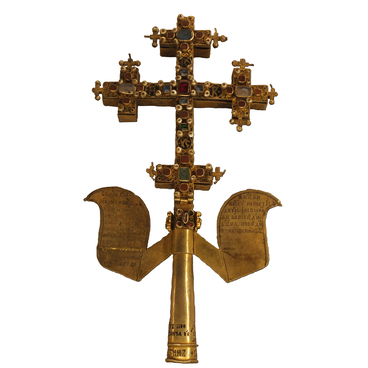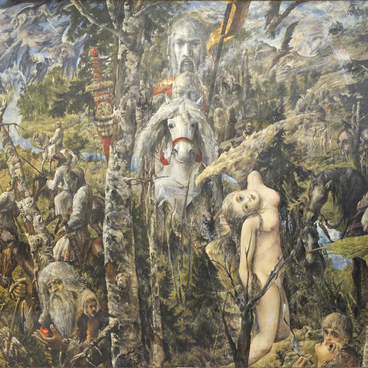Anthony, the Abbot of the Pokrovsky Monastery in Uglich martyred in 1610 during the Time of Troubles, owned this cross of the 16th century. The Uglich Chronicle, a historical and literary manuscript, informs that the abbot Anthony came with this cross to Polish troops that had surrounded the monastery. They killed the abbot and monks who came with him but failed to take the monastery immediately and encamped near its walls. At night, monks went out of the monastery to take and buried dead bodies. Then they must have found the damaged Anthony’s cross.
The abbot must have met the troops with a processional cross, a cross that is located behind the altar near the east wall of the sanctuary and used in outdoor cross-processions. The pole of the ancient artifact is tapered, probably, to fix it securely in the pedestal representing Golgotha. The figure of Jesus on the cross is disproportionally stretched and bent, elbow curves on his stretched hands can be hardly seen, and his palms are outlined schematically. Ribs, chest and stomach muscles are depicted in thin dynamic lines. The manner of carving can inform about an approximate time and place of the cross creation. It must have been made in north regions in one of monasteries near Lake Beloye in the Vologda Region. The material of the cross proves it, as according to monastery records of the 17th century at that time monasteries had large processional crosses made from bone.
According to one of the versions, this cross was brought to Uglich from the Ferapontov Monastery. In October of 1848, Saint Martinian Belozersky, the former abbot of this monastery, was invited to take part in the consecration of the church of the Pokrovsky Monastery and he could have given this cross as a gift to the new church.
The abbot must have met the troops with a processional cross, a cross that is located behind the altar near the east wall of the sanctuary and used in outdoor cross-processions. The pole of the ancient artifact is tapered, probably, to fix it securely in the pedestal representing Golgotha. The figure of Jesus on the cross is disproportionally stretched and bent, elbow curves on his stretched hands can be hardly seen, and his palms are outlined schematically. Ribs, chest and stomach muscles are depicted in thin dynamic lines. The manner of carving can inform about an approximate time and place of the cross creation. It must have been made in north regions in one of monasteries near Lake Beloye in the Vologda Region. The material of the cross proves it, as according to monastery records of the 17th century at that time monasteries had large processional crosses made from bone.
According to one of the versions, this cross was brought to Uglich from the Ferapontov Monastery. In October of 1848, Saint Martinian Belozersky, the former abbot of this monastery, was invited to take part in the consecration of the church of the Pokrovsky Monastery and he could have given this cross as a gift to the new church.




